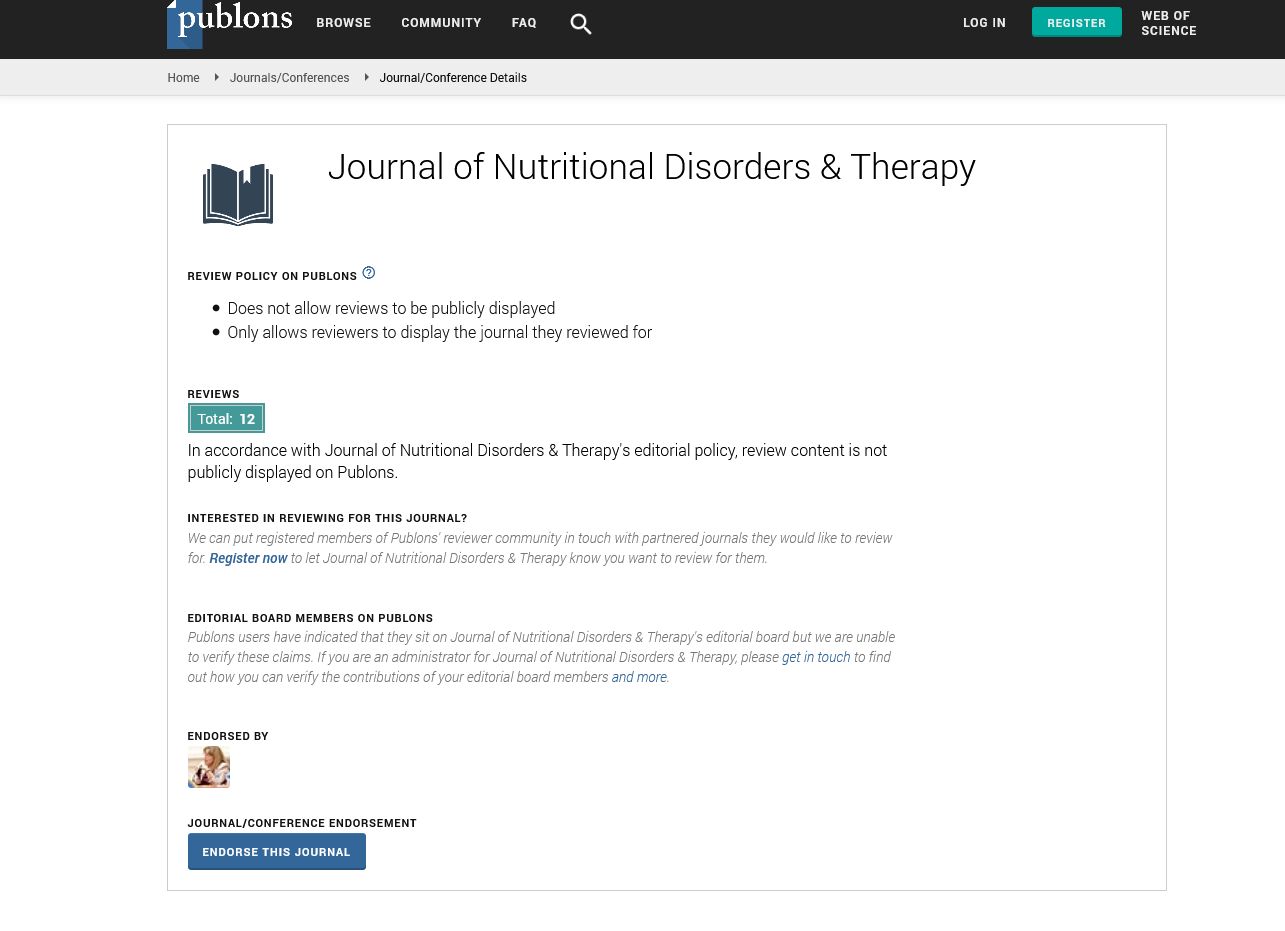Indexed In
- Open J Gate
- Genamics JournalSeek
- Academic Keys
- JournalTOCs
- Ulrich's Periodicals Directory
- RefSeek
- Hamdard University
- EBSCO A-Z
- OCLC- WorldCat
- Publons
- Geneva Foundation for Medical Education and Research
- Euro Pub
Useful Links
Share This Page
Journal Flyer

Open Access Journals
- Agri and Aquaculture
- Biochemistry
- Bioinformatics & Systems Biology
- Business & Management
- Chemistry
- Clinical Sciences
- Engineering
- Food & Nutrition
- General Science
- Genetics & Molecular Biology
- Immunology & Microbiology
- Medical Sciences
- Neuroscience & Psychology
- Nursing & Health Care
- Pharmaceutical Sciences
Perspective - (2024) Volume 14, Issue 4
The Impact of the Ketogenic Diet on Growth and Bone Health in Infants with Epilepsy
Constanze Sutter*Received: 22-Nov-2024, Manuscript No. JNDT-24-27636; Editor assigned: 25-Nov-2024, Pre QC No. JNDT-24-27636(PQ); Reviewed: 09-Dec-2024, QC No. JNDT-24-27636; Revised: 16-Dec-2024, Manuscript No. JNDT-24-27636(R); Published: 23-Dec-2024, DOI: 10.35248/2161-0509.24.14.314
Description
The Ketogenic Diet (KD), a high-fat, low-carbohydrate and moderate-protein nutritional regimen, has long been recognized as an effective treatment for refractory epilepsy. Its use in pediatric populations, especially infants under 12 months old, has garnered increasing attention due to its significant potential to control seizures where pharmacological interventions fail. However, a critical concern remains the impact of the ketogenic diet on growth and overall development during this essential period of infancy, when growth velocity is at its peak. This article synthesizes findings from systematic reviews and an analysis of infant data to explore how ketogenic diet therapy affects growth in infants with epilepsy.
The ketogenic diet induces a state of ketosis, where the body shifts from using glucose as its primary energy source to metabolizing fat into ketones, which serve as an alternative fuel. This metabolic shift has demonstrated remarkable efficacy in reducing seizures, particularly in cases of refractory epilepsy that do not respond to standard antiepileptic drugs. Despite its success in seizure management, concerns about potential side effects, such as nutrient deficiencies and impaired growth, have prompted investigations into its broader implications.
Growth velocity, particularly during the first year of life, is an essential marker of an infant's health and nutritional status. Infants grow rapidly during this time, requiring adequate macronutrients and micronutrients to support skeletal, muscular and neurological development. The ketogenic diet, while effective for epilepsy management, inherently limits carbohydrate intake and may inadvertently lead to deficiencies in essential nutrients such as calcium, phosphorus and vitamin D. These limitations pose a risk to both linear growth and weight gain.
Existing literature highlights growth deceleration as a potential side effect of ketogenic diet therapy. Factors contributing to this include reduced calorie intake, inadequate protein for growth and restricted micronutrients essential for bone development. The challenge, therefore, lies in balancing the therapeutic benefits of seizure control with the need to ensure adequate nutrition to support optimal growth.
A systematic review of existing research on ketogenic diet therapy in infants under 12 months sheds light on its effects on growth velocity. Several key studies have reported growth deceleration in infants undergoing this dietary therapy, though the degree of impact varies based on factors such as diet formulation, duration of therapy and initial nutritional status.
One prominent study found that while the ketogenic diet significantly reduced seizure frequency in over 70% of infant participants, nearly 30% experienced growth faltering after six months of therapy. This effect was particularly pronounced in infants with pre-existing malnutrition or those on more restrictive formulations of the diet. Another study emphasized the importance of careful diet monitoring, reporting that infants receiving a modified ketogenic diet with tailored supplementation showed less pronounced growth impairment compared to those on stricter regimens.
Data also suggest that the timing of diet initiation plays a role in growth outcomes. Infants who began the ketogenic diet at earlier stages of epilepsy treatment and with adequate baseline nutritional reserves demonstrated better growth outcomes than those who started later or were already malnourished.
A retrospective analysis of infant data provided additional insights into the relationship between ketogenic diet therapy and growth. The study tracked growth metrics, including weight-forage and length-for-age z-scores, in a cohort of infants with epilepsy over a 12-month period.
The findings revealed that while seizure control improved significantly in the majority of participants, there was a notable decline in growth metrics in approximately 35% of the infants. However, those who received individualized dietary adjustments, including increased protein intake and micronutrient supplementation, exhibited a lesser degree of growth impairment. This underscores the importance of personalized dietary management to mitigate potential adverse effects on growth. Additionally, infants with better parental compliance to prescribed supplementation regimens and regular follow-up consultations with dietitians showed more favorable growth outcomes. This highlights the critical role of multidisciplinary care in managing ketogenic diet therapy.
Customized Diet Plans Tailoring the ketogenic diet to include adequate protein and calories while maintaining ketosis can help support growth. Micronutrient Supplementation Ensuring sufficient intake of vitamins and minerals such as calcium, vitamin D and iron is important for bone health and overall development. Regular Monitoring Frequent growth assessments, including weight, length and head circumference measurements, enable early detection of growth deceleration and allow for timely interventions.
Conclusion
Autosomal Recessive Hypophosphatemic Rickets Type 2 (ARHR2), caused by ENPP1 deficiency, is a rare but clinically significant disorder that disrupts phosphate metabolism and leads to defective bone mineralization. While vitamin D plays a well-known role in bone health, ARHR2 highlights the critical importance of phosphate regulation in maintaining bone integrity. Early diagnosis through biochemical testing and genetic analysis, along with appropriate phosphate supplementation, is essential for managing this condition and preventing further complications.
Citation: Sutter C (2024). The Impact of the Ketogenic Diet on Growth and Bone Health in Infants with Epilepsy. J Nutr Disord Ther. 14:314.
Copyright: © 2024 Sutter C. This is an open-access article distributed under the terms of the Creative Commons Attribution License, which permits unrestricted use, distribution, and reproduction in any medium, provided the original author and source are credited.

